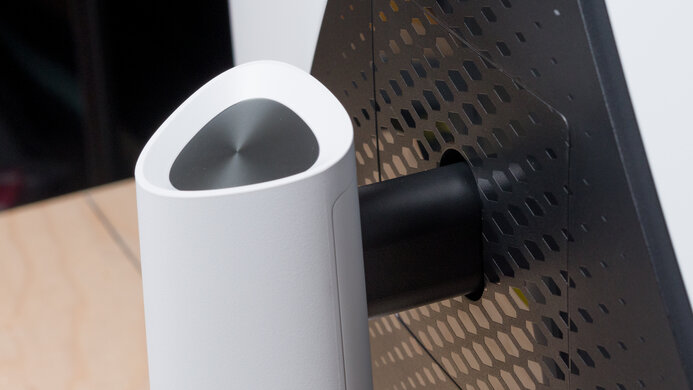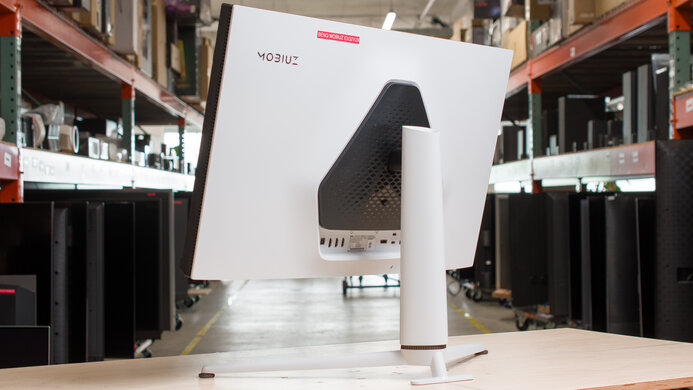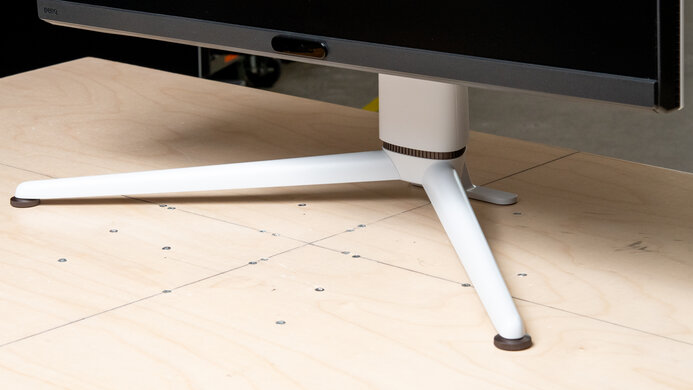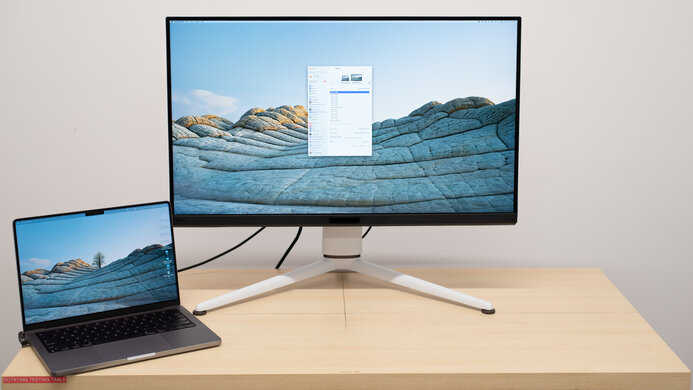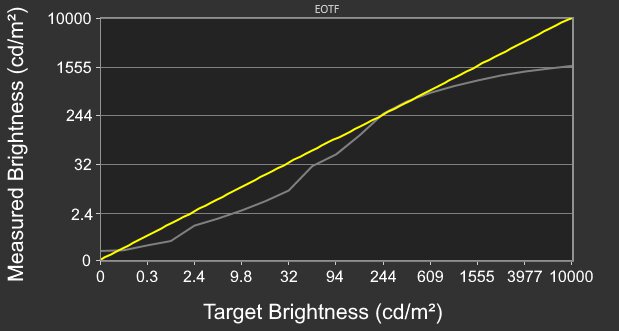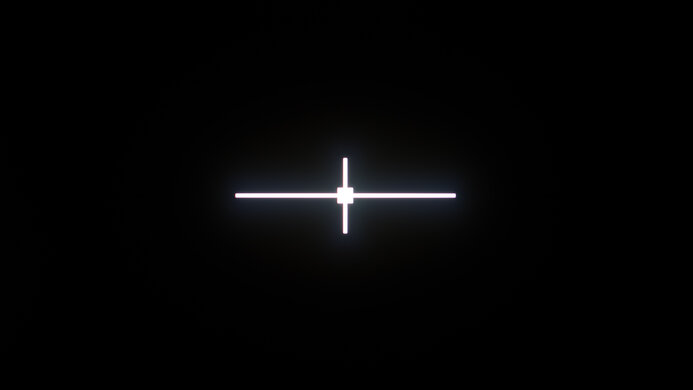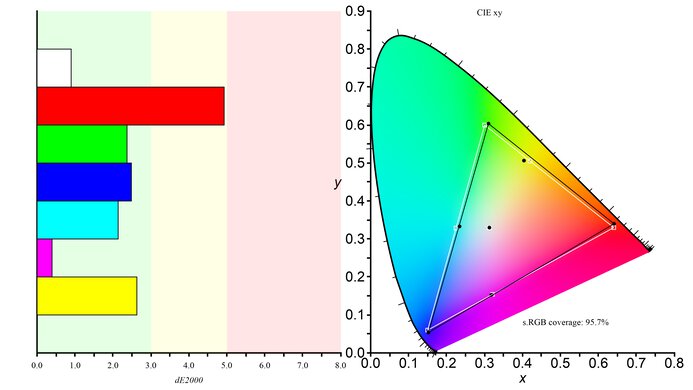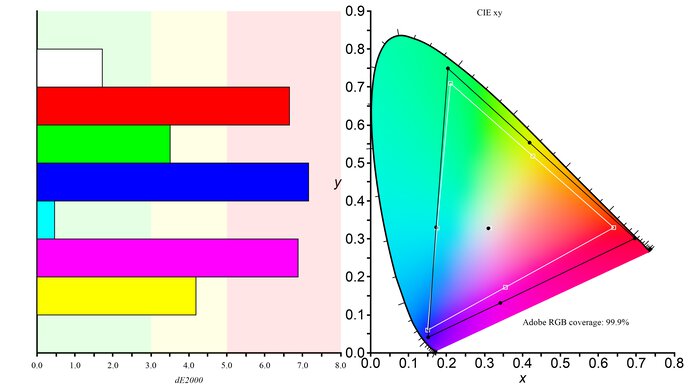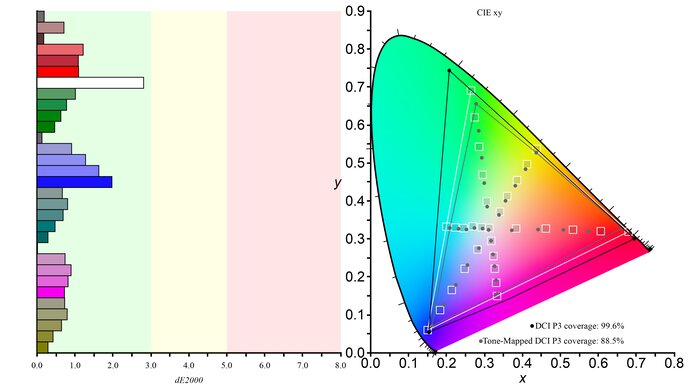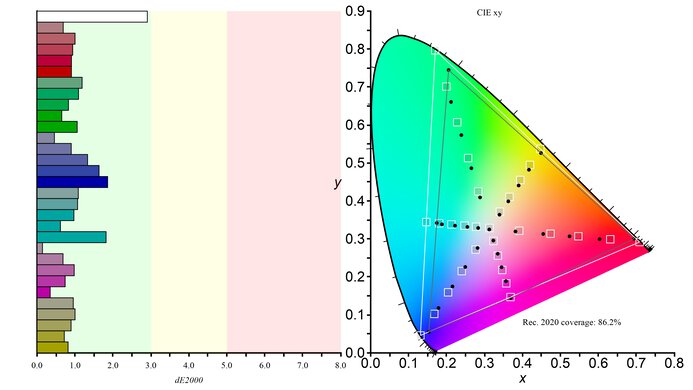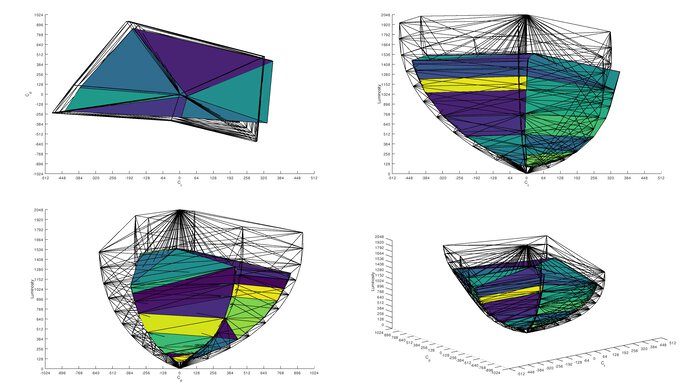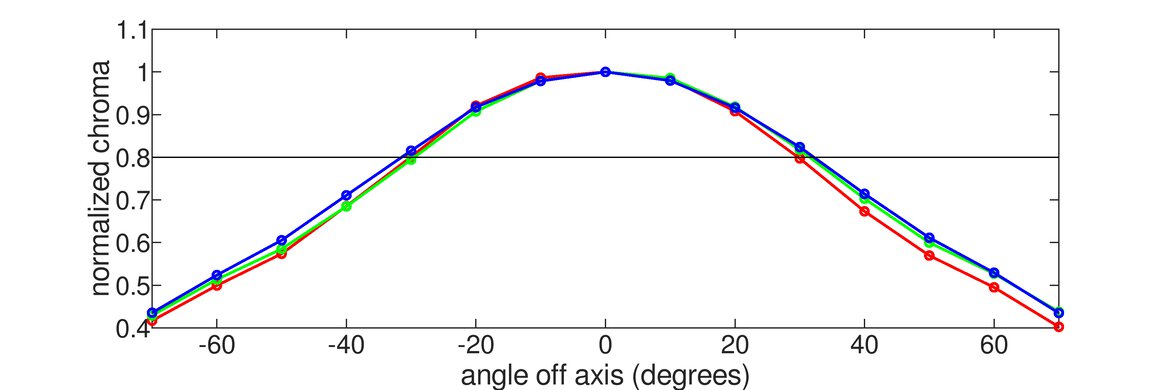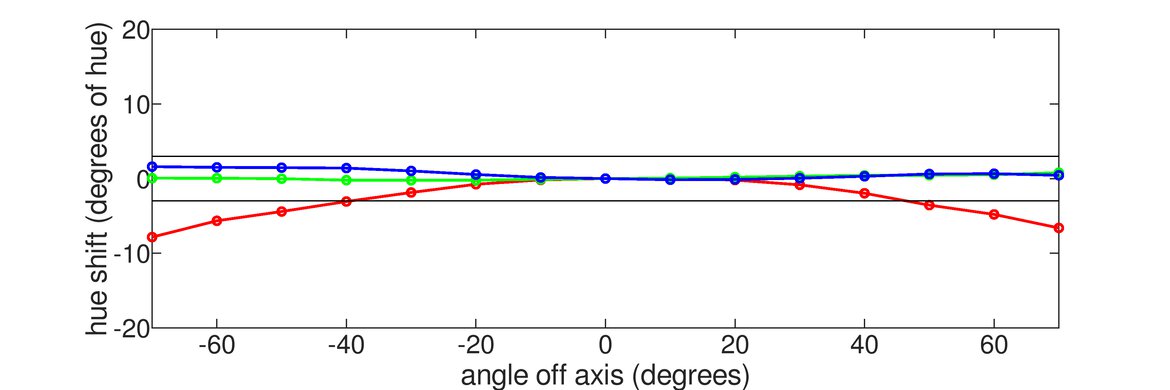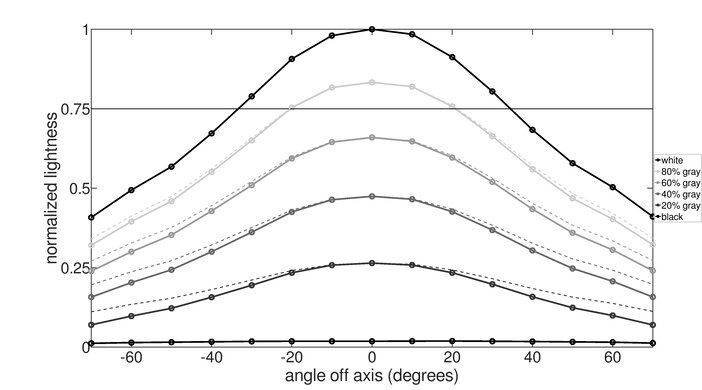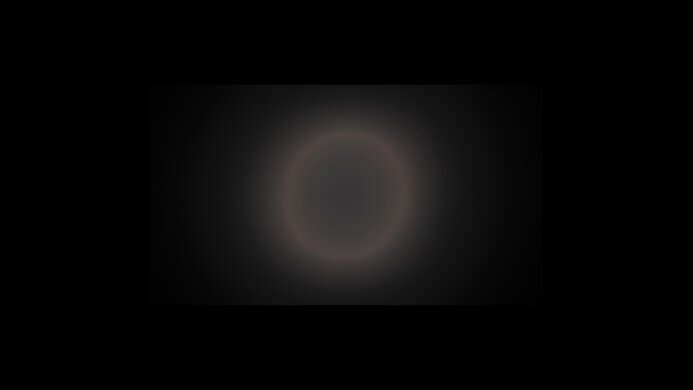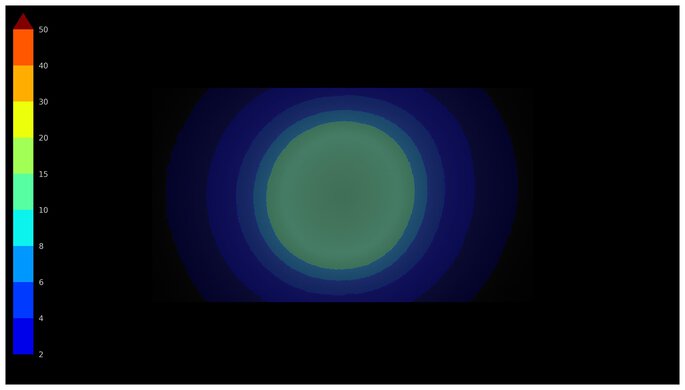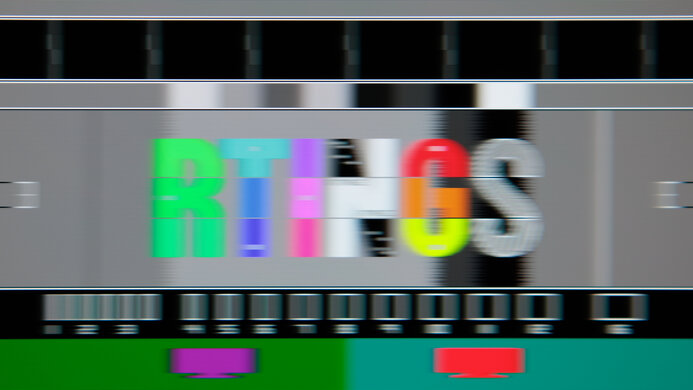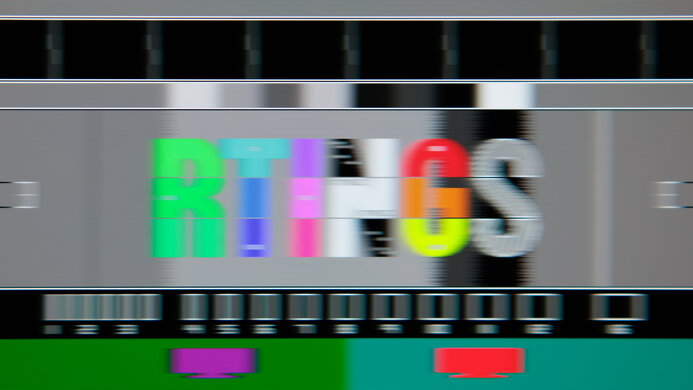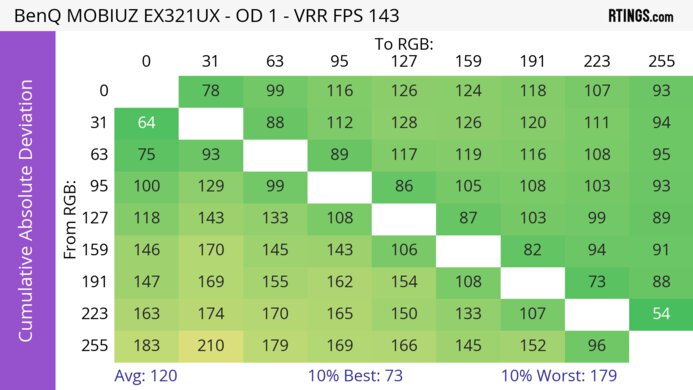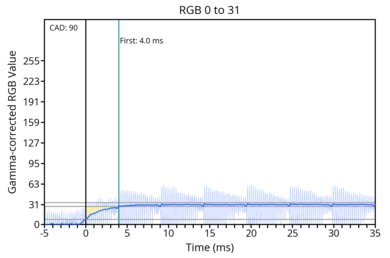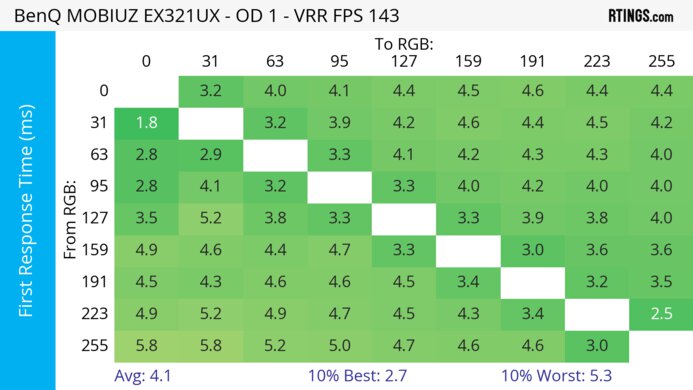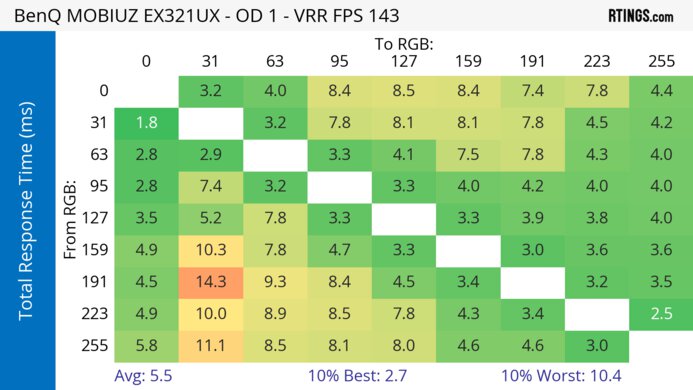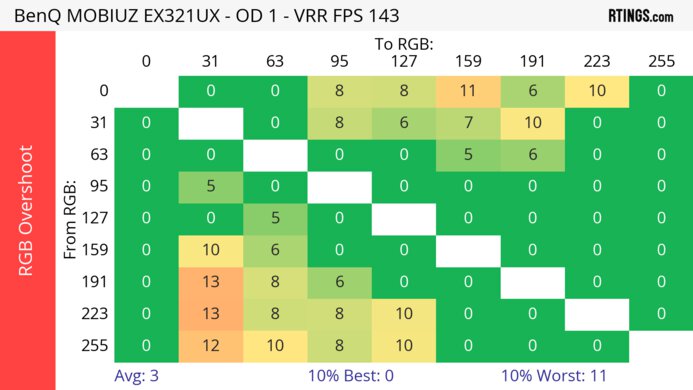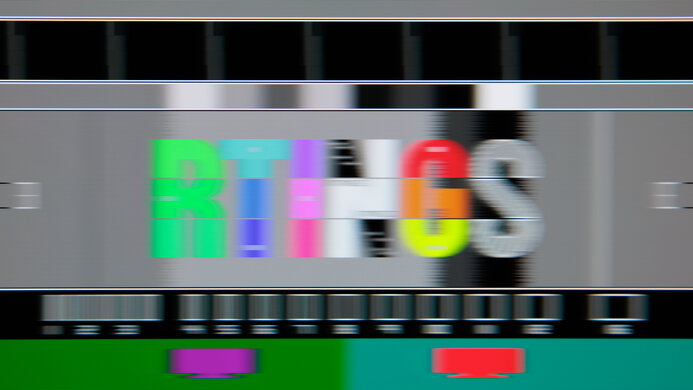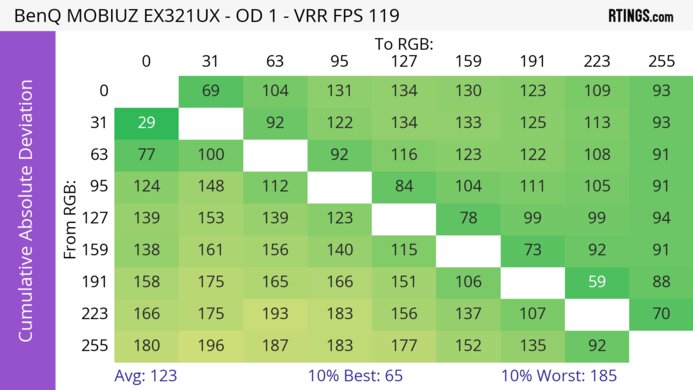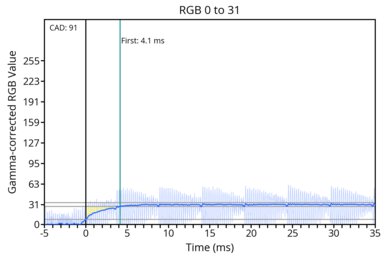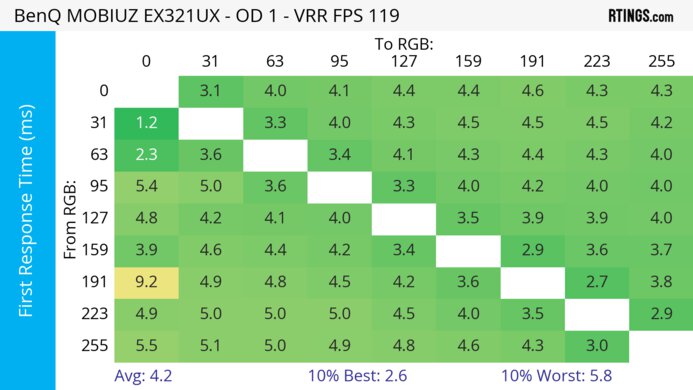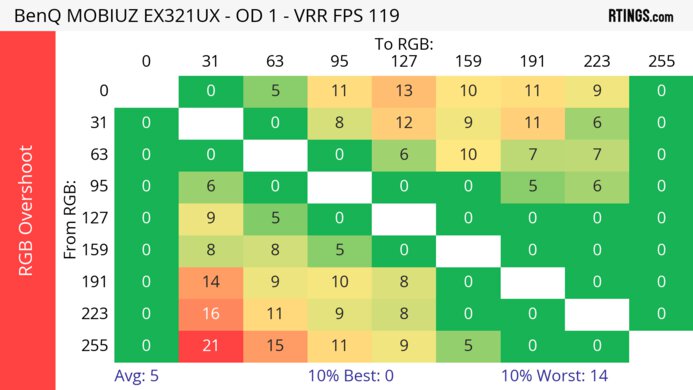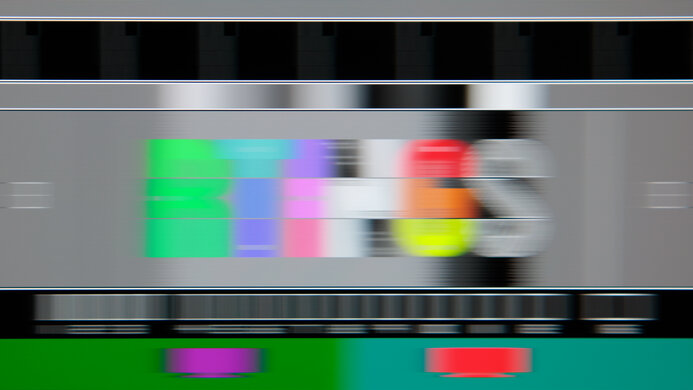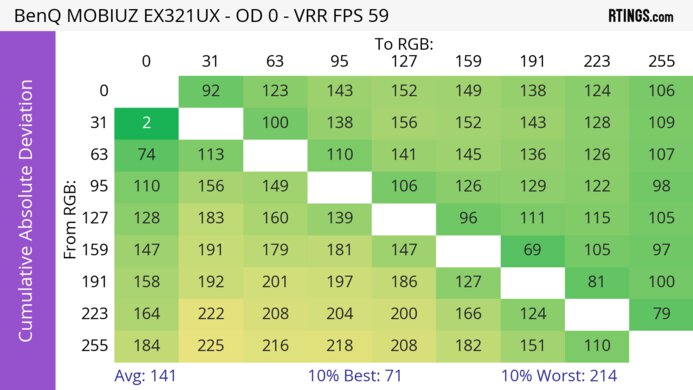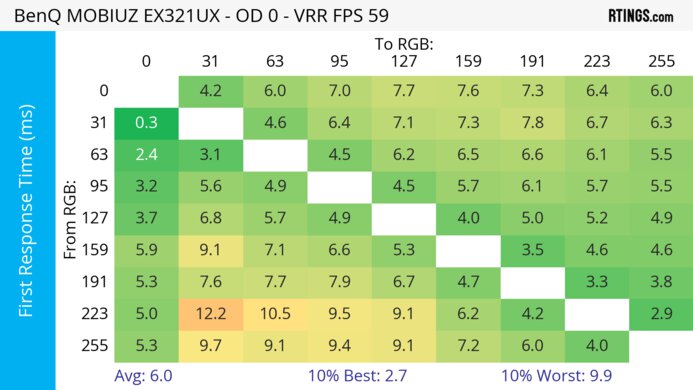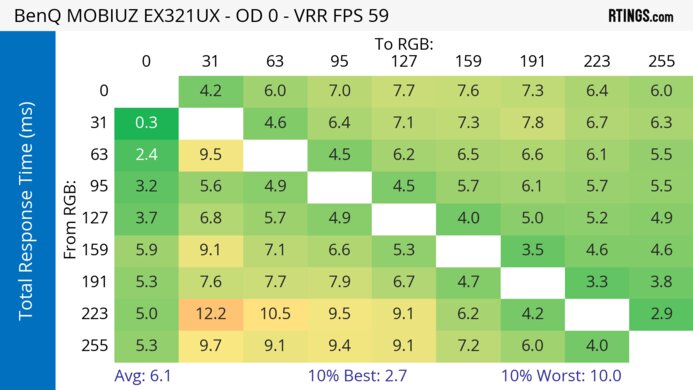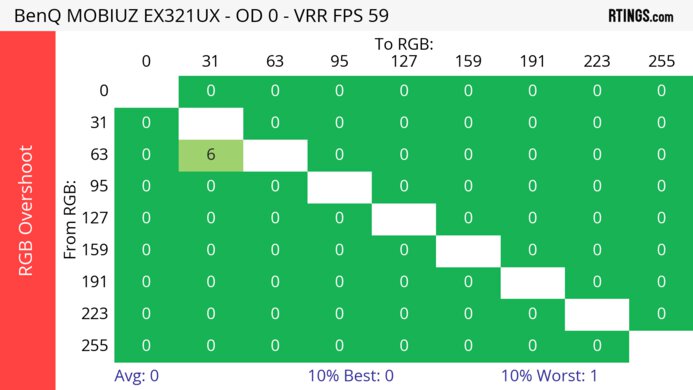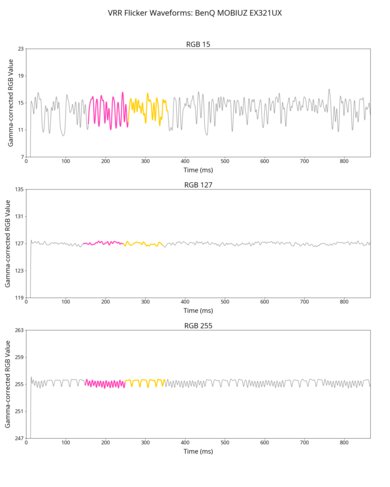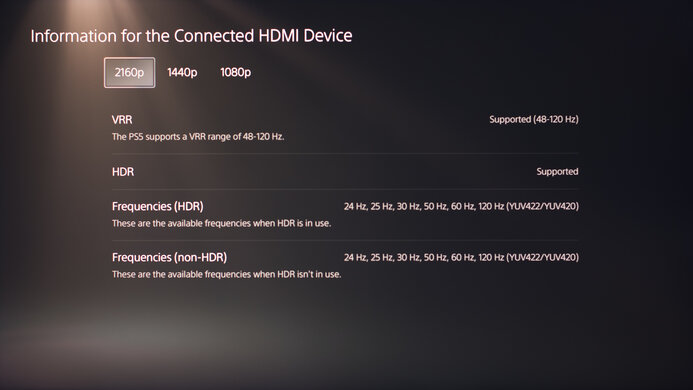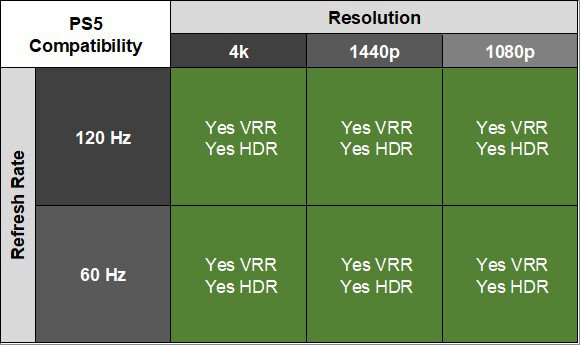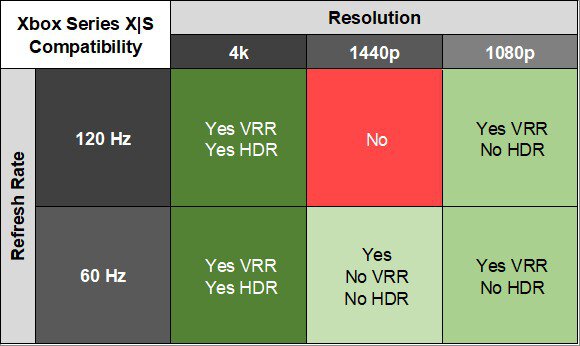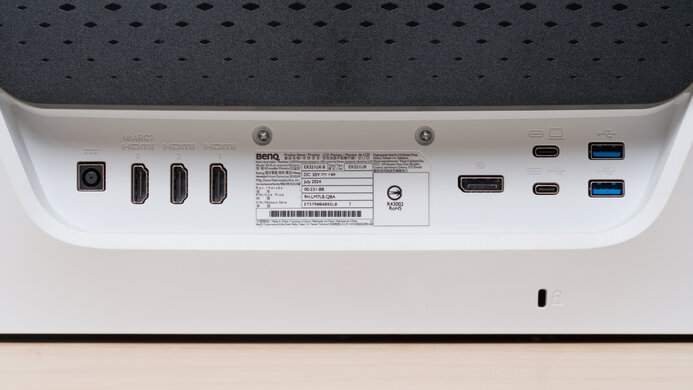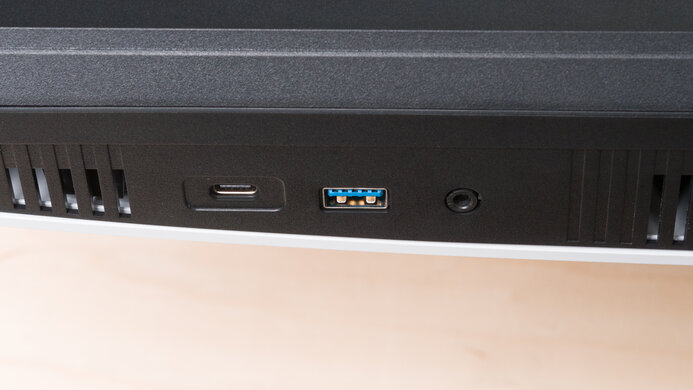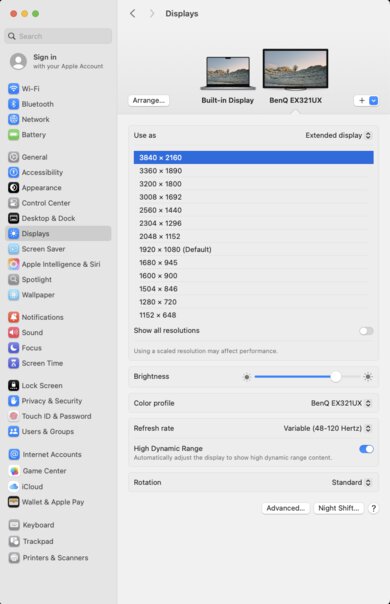The BenQ MOBIUZ EX321UX is a 32-inch 4k Mini LED gaming monitor. It competes with other 32-inch Mini LED monitors like the ASUS ROG Swift PG32UQX, the Acer Predator X32 FP, and the ViewSonic Elite XG321UG. It's a significant improvement over its predecessor, the EX3210U, which has just 16 local dimming zones. The newer EX321UX has 1,152 zones and has several additional features, such as DisplayPort 2.1 support, USB-C connectivity with 65W of power delivery, and a KVM switch. It also comes with a wireless remote to control the monitor's settings, an ARC/eARC port to connect to soundbars or receivers, and a light tuner setting to increase the brightness of dark shadows.
Our Verdict
The BenQ MOBIUZ EX321UX is good for PC gaming. Its 144Hz refresh rate and low input lag create a fairly responsive feel, and its great motion handling makes fast-moving objects look crisp. Additionally, if you enable local dimming its contrast is excellent, though deep blacks appear gray when it's off. Additionally, it gets extremely bright, and easily overcomes glare and makes highlights pop. It also displays a wide range of colors quite vividly.
Fast-moving objects look quite crisp.
Alright local dimming system.
Highlights pop in HDR.
Displays a very wide range of colors in HDR.
Supports all VRR formats.
Mediocre native contrast.
Local dimming causes a bit of blooming.
The BenQ MOBIUZ EX321UX is amazing for console gaming. It supports all features of the PS5, PS5 Pro, and Xbox Series X|S. Additionally, highlights pop in HDR and it displays a wide range of colors very vividly. It also has low input lag for a responsive feel, and great motion handling, so fast-moving objects look crisp. It also has great contrast when its local dimming is enabled, though it causes a bit of blooming.
Fast-moving objects look quite crisp.
Alright local dimming system.
Highlights pop in HDR.
Displays a very wide range of colors in HDR.
Supports VRR with PS5, PS5 Pro, and Xbox Series X|S.
Local dimming causes a bit of blooming.
The BenQ MOBIUZ EX321UX is impressive for office work. It has superb text clarity and image sharpness. Additionally, it has adequate reflection handling and exceptional brightness, so it works extremely well in a bright environment. However, while it has good height adjustment, it doesn't swivel very much, so it's not ideal if you plan to share your screen with others.
Extremely bright in SDR.
Good viewing angles.
Good height adjustment.
Very sharp text and images.
Limited swivel range.
The BenQ EX321UX is great for editing. Because of its 4k resolution images and text look quite sharp. It also displays a wide range of colors in SDR and HDR quite vividly. And while deep blacks appear gray without local dimming, it has excellent contrast when local dimming is on, though it causes a bit of blooming. It also gets bright enough to pop in HDR and has very little ambient black level rise in a bright room, so it's great for editing dark parts of scenes in bright environments. However, it doesn't swivel very much, so it's not great for sharing work with a colleague.
Extremely bright in SDR.
Good viewing angles.
Good height adjustment.
Displays a very wide range of colors in HDR.
Excellent contrast with local dimming enabled.
Very sharp text and images.
Limited swivel range.
Mediocre native contrast.
Local dimming causes a bit of blooming.
The BenQ EX321UX has superb brightness. It gets exceptionally bright in SDR, and highlights pop in HDR.
Extremely bright in SDR.
Highlights pop in HDR.
The BenQ EX321UX has an impressive response time. Fast-moving objects look quite crisp across its VRR range, and there isn't much inverse ghosting.
Fast-moving objects look quite crisp.
The BenQ MOBIUZ EX321UX has good HDR picture quality. It displays a wide range of colors quite vividly. Additionally, its local dimming system significantly improves contrast, though it does cause some blooming.
Alright local dimming system.
Displays a very wide range of colors in HDR.
Local dimming causes a bit of blooming.
The BenQ EX321UX has decent SDR picture quality. It has good black uniformity and displays the SDR gamut well. However, unless you enable local dimming its contrast is mediocre.
Good black uniformity.
Excellent contrast with local dimming enabled.
Mediocre native contrast.
The BenQ EX321UX has amazing color accuracy. It has excellent accuracy before calibration, and all parts of scenes are the correct brightness. It also has great gray uniformity.
Amazing accuracy before calibration.
Great gray uniformity.
All parts of scenes are the correct brightness.
Performance Usages
Changelog
-
Updated Nov 13, 2025:
We clarified that the Acer Nitro XV275K P5biipruzx is a smaller alternative for those who want something that costs less.
- Updated Nov 10, 2025: We've converted this review to Test Bench 2.1.1. We removed the Vertical Viewing Angle test.
-
Updated Sep 24, 2025:
We corrected a test result to clarify that it doesn't have built-in speakers.
-
Updated Sep 18, 2025:
We clarified the text in Local Dimming for accuracy and to specify the number of dimming zones it has.
Check Price
Differences Between Sizes And Variants
We tested the BenQ MOBIUZ EX321UX, the first BenQ model to offer Mini LED dimming. As you can see below, BenQ has two similar models without Mini LED dimming. However, the non-mini LED models are different monitors, and the results are only valid for the MOBIUZ EX321UX.
| Model | Size | Resolution | Max Refresh Rate | Local Dimming System |
|---|---|---|---|---|
| MOBIUZ EX321UX | 32" | 4k | 144Hz | Mini LED Full-Array |
| MOBIUZ EX3210U | 32" | 4k | 144Hz | Edge-Lit |
| MOBIUZ EX2710U | 27" | 4k | 144Hz | Edge-Lit |
Our unit's label indicates it was manufactured in July 2024. You can see a photo of its label here. It was tested with firmware V5.
Popular Monitor Comparisons
The BenQ MOBIUZ EX321UX is a 32-inch 4k Mini LED gaming monitor. It's an outstanding choice for someone who wants a 32-inch monitor for work and gaming, and doesn't want to worry about the risk of burn-in that can come with OLEDs when used for work. It's extremely versatile, as it displays fairly deep blacks if you use its local dimming system, has great motion handling, and displays a wide range of colors quite vividly. It also has excellent connectivity. However, its standout feature is its performance in bright environments. It gets bright enough to easily overcome any glare and make highlights pop, and it has very little ambient black level rise in bright environments.
That said, these capabilities come with a premium price, and the Acer Nitro XV275K P5biipruzx also offers very similar gaming and work performance in a 27-inch size for considerably less money. Additionally, if you only plan to use your monitor for gaming, you can find 32-inch OLEDs with better motion handling and deeper blacks for a similar price, such as the MSI MPG 321URX QD-OLED. However, if you're looking for a 32-inch monitor that works equally well for productivity, editing, and gaming, the BenQ MOBIUZ EX321UX is a fantastic option.
See our recommendations for the best 4k gaming monitors, the best Mini LED monitors, and the best 4k HDR monitors.
The Samsung Odyssey Neo G8 S32BG85 and the BenQ MOBIUZ EX321UX are 32-inch 4k Mini LED gaming monitors. The BenQ is the better option for most people, as it has more vivid colors, very little VRR flicker, wider viewing angles, and much better connectivity. However, you may prefer the Samsung if you game in a dark room, as it has much better contrast. It also feels more responsive because of its higher 240Hz refresh rate.
The BenQ MOBIUZ EX321UX and the Acer Nitro XV275K P5biipruzx are both 4k Mini LED monitors, with a few differences. With the BenQ, you can enable or disable local dimming as you wish, and it helps improve the picture quality with deeper blacks, but it has some haloing around bright objects. That said, the local dimming feature on the Acer has more haloing, and it automatically turns on in HDR, as you can't turn it off or use it in SDR. The BenQ has a few other advantages in picture quality as it gets much brighter and has more accurate colors. While the BenQ has better overall motion handling, the Acer is more versatile for playing different types of games. It has a dual-mode feature that switches its native 4k resolution and 160Hz refresh rate to 1080p, 320Hz for a smoother feel.
The Acer Nitro XV275K P3biipruzx and the BenQ MOBIUZ EX321UX are both 4k Mini LED gaming monitors. Both monitors have largely similar motion handling, HDR brightness, and color vividness, and are excellent options if you plan on gaming and working on the same monitor. The biggest difference between them is their size. The Acer is a better choice if you prefer a 27-inch display or are looking for a monitor in a lower price category. However, the BenQ is a better choice if you want a 32-inch display.
The ASUS ROG Swift OLED PG32UCDP and the BenQ MOBIUZ EX321UX are both 32-inch 4k gaming monitors. The ASUS is a better option if you're planning to use your monitor mainly for gaming, as it has a higher refresh rate, much better contrast in a dark room, and far better motion handling. However, the BenQ is a better option if you plan on using your monitor for work as well as gaming, as it has no risk of burn-in, and is far better at overcoming glare.
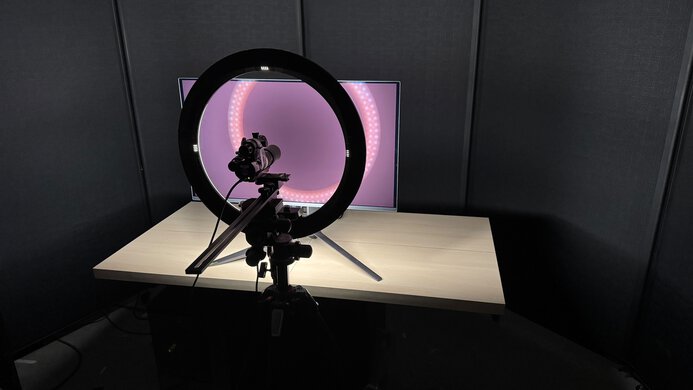
We buy and test more than 30 monitors each year, with units that we buy completely on our own, without any cherry-picked units or samples. We put a lot into each unbiased, straight-to-the-point review, and there's a whole process from purchasing to publishing, involving multiple teams and people. We do more than just use the monitor for a week; we use specialized and custom tools to measure various aspects with objective data-based results. We also consider multiple factors before making any recommendations, including the monitor's cost, its performance against the competition, and whether or not it's easy to find.
Test Results

The build quality is great. The plastics have a nice finish, and there's no creaking in the plastic housing, though the back of the monitor does flex a bit. There are no defects in the bezels.
There are vents all around the top and bottom of the monitor to help it cool, and there seems to be a lot of empty space inside the monitor's housing for cooling. Additionally, while the remote is lightweight, it feels solid.
The ergonomics are mediocre. While it has good height adjustment and a mediocre tilt range, it doesn't swivel very much, so it's not ideal if you want to share your screen with others. Additionally, while it rotates three degrees in either direction for leveling, it doesn't rotate into portrait.
The stand is very large and takes up a lot of room in front of the monitor. However, it holds the monitor well, as it has very little wobble when bumped and recovers quickly afterward. The monitor feet aren't height-adjustable.
The thickness measurement is from the back of the monitor's support foot.
This BenQ MOBIUZ EX321UX has a remote you can use to adjust the on-screen settings. If you prefer to adjust the monitor's settings without the remote, you can also use the monitor's integrated buttons, which include an input selector key, a joystick to control the on-screen display, and a power button.
The local dimming is alright. It uses Mini LED backlighting with 1,152 dimming zones, and there's a Local Dimming setting to turn it on and off. It really improves the black levels and contrast for an impactful HDR experience, but there are some issues. There's some blooming around bright objects, like subtitles, but it's not overly distracting with most content. That said, it's more noticeable when browsing the web, so you may prefer disabling local dimming when you aren't gaming or watching content.
Using local dimming doesn't make small highlights against dark backgrounds pop more compared to not using the feature, like in a scene with a starfield. Some details are also lost in very dark scenes. However, it still improves the picture quality compared to SDR, so it's worth using local dimming in HDR.
Unfortunately, the algorithm doesn't keep up well when fast-moving objects move between the dimming zones. Transitions are choppy, and there's pulsing/flicker with small and medium-sized objects. This is distracting with fast-moving content.
Another downside is that using the OSD with local dimming enabled doesn't trigger any of the zones, so the menu is hard to see if there's a dark background on-screen.
Settings
- Color Mode: Custom (after calibration)
- Brightness: Max
- Local Dimming: On
The SDR brightness is outstanding. It easily overcomes extremely bright glare, and the brightness level remains fairly consistent with all but the smallest window sizes. The minimum brightness measurement is with Local Dimming 'Off'. If you turn it 'On', the minimum brightness is 50 cd/m².
If you turn Local Dimming 'Off', brightness decreases, as you can see below:
| Test | Peak | Sustained |
|---|---|---|
| 2% Window | 646 cd/m² | 644 cd/m² |
| 10% Window | 650 cd/m² | 649 cd/m² |
| 25% Window | 652 cd/m² | 651 cd/m² |
| 50% Window | 654 cd/m² | 652 cd/m² |
| 100% Window | 655 cd/m² | 653 cd/m² |
Settings
- Color Mode: Display HDR
- Brightness: Max
- Local Dimming: On
The HDR brightness is outstanding, and all highlights really pop. However, it doesn't follow the PQ EOTF very well, as most parts of scenes are too dark, and it has a slow roll-off near peak brightness. This prevents highlights from getting as bright as possible, but helps preserve bright details.
The 'Sci-Fi', 'Realistic', 'Fantasy', and 'Cinema' Color Mode settings don't lock out any picture settings and allow a lot of customization. However, their EOTF tracking and color accuracy were worse than 'DisplayHDR', which locks out the following settings:
- Light Tuner
- Color Vibrance
- Shadow Phage
- B.I.+
- Gamma
- Contrast
- Color Temperature
The gray uniformity is great. Though the edges of the monitor are a bit darker, it's quite uniform in the middle. You can also see the monitor's 5% gray uniformity.
The accuracy before calibration in the 'sRGB' Color Mode is amazing. It locks colors extremely well to the sRGB color space, and has great color accuracy. Gamma also follows the sRGB curve very closely. However, despite having good white balance, brighter colors are too warm.
Using the sRGB mode locks the following settings.
-
Color Mode
- Light Tuner
- Color Vibrance
- Shadow Phage
- B.I +
- Gamma
- Color Temperature
- Local Dimming
-
Eye Care
- Low Blue Light
- Color Weakness
You have to use a less accurate mode to get access to these settings.
The accuracy after calibration is fantastic. However, some colors, such as orange, are less accurate than before calibration. The monitor only lets you improve the picture by adjusting Color Temperature and Color Vibrance, and there are no more detailed adjustments available on the monitor.
The SDR color gamut is superb. It displays most colors in sRGB and nearly all colors in Adobe RGB. Although some colors, such as red, blue, and magenta, are inaccurate in Adobe RGB, you may be able to avoid this issue with a color-managed app.
The HDR color gamut is outstanding. It displays nearly all colors in the commonly used DCI-P3 color space and a wide range of colors in Rec. 2020, and it does so quite accurately.
The horizontal viewing angle is decent. It works well if you're sharing your screen with someone who's just off-center next to you, but it washes out at wider angles.
The direct reflection handling is okay. Bright objects don't look very distinct, as the matte screen spreads light out.
The black levels remain superbly low in bright environments.
You don't need to use DSC to reach the monitor's max refresh rate of 144Hz over DisplayPort if your graphics card supports DisplayPort 2.1 (40Gbps or higher). Additionally, you don't need to use DSC with HDMI to reach the max refresh rate, provided your graphics card supports HDMI 2.1 (40Gbps or higher).
If your graphics card only supports DisplayPort 1.4 bandwidth (HBR3), then you need to use DSC to reach the max refresh rate.
NVIDIA - G-SYNC Compatibility
Connection
VRR Min
VRR Max
DisplayPort
<20Hz
144Hz
HDMI
<20Hz
144Hz
AMD - FreeSync Compatibility
Connection
VRR Min
VRR Max
DisplayPort
<20Hz
144Hz
HDMI
<20Hz
144Hz
In addition to FreeSync and G-SYNC compatibility, this monitor also supports HDMI Forum VRR.
The BenQ EX321UX has great motion handling across its VRR range. The 'OD 1' AMA has minimal blur and is fairly consistent at different refresh rates. The 'OD 3' setting has such a high CAD that it passes the limits of the chart, though you can see an alternate chart with a larger scale.
The refresh rate compliance is great. However, it's not fast enough to make full color transitions between some frames.
The CAD at the max refresh rate is impressive, and fast-moving objects look quite crisp. The '1' AMA setting has the lowest total response time and only a bit more inverse ghosting than '0'.
The CAD at 120Hz is impressive, and fast-moving objects look quite crisp. The '1' AMA setting has a lower first response time than '0' and less inverse ghosting than '2' or '3'.
The CAD at 60Hz is great, and fast-moving objects look fairly crisp. The '0' AMA setting has a lower total response time and less inverse ghosting than '1', '2', or '3'.
This BenQ MOBIUZ EX321UX doesn't have a backlight strobing feature to reduce persistence blur.
This monitor uses pulse width modulation (PWM) at all brightness levels, though it's at such a high frequency that you don't notice it.
This monitor has two layers of oscillation: a 4,000Hz PWM frequency nested within a 200Hz backlight partial-dimming frequency. The slower 200Hz frequency doesn't dim very much each cycle, as you can see in our partial-dimming oscilloscope graph. The full PWM flicker itself happens at 4,000Hz, as you can see in our PWM flicker oscilloscope graph. So while it technically flickers, the effect is unnoticeable, which is why we term it "Flicker-Free".
The BenQ EX321UX has low input lag for a responsive feel.
This monitor doesn't display a 1440p @ 120Hz signal from the Xbox Series X|S, even using the console's override function. However, while 1440p @ 60Hz required the override function, it did work.
The Xbox Series X|S only supports HDR with 4k signals, so this isn't a limitation of the monitor.
The HDMI3 port doubles as an ARC/eARC port, allowing digital audio passthrough to compatible devices such as soundbars and receivers. The included remote can be used to adjust the audio device's volume.
The USB-C port on the underside of the monitor provides up to 6.9W of power.
Connection
HDMI 2.1
USB-C
Max Refresh Rate
144Hz
144Hz
VRR Range
48-120Hz
48-120Hz
HDR
Yes
Yes
The BenQ MOBIUZ EX321UX works well with macOS. VRR works well, and HDR looks good with certain Color Mode settings. 'Sci-fi' looks most accurate over USB-C, though 'Cinema' also looks good despite being too dark. Additionally, the default 'Fantasy' Color Mode looks less accurate over HDMI, and 'Display HDR' looks much better.
If you connect the monitor to a MacBook with an HDMI or USB-C cable and the MacBook is plugged in, windows migrate to the monitor when you close the lid. Additionally, they return to their previous position if the MacBook is reopened. This also happens if you connect via USB-C and the MacBook isn't plugged in.
However, if you connect over HDMI and the MacBook isn't plugged in, the MacBook and monitor go to sleep. When you reopen the MacBook windows resume in their previous position.
Additionally, the KVM works well with macOS.
The BenQ MOBIUZ EX321UX has several extra features, including a KVM switch, which allows you to switch between two computers while using the same peripherals. It takes about five seconds to switch between devices, which you can do using the input button on the monitor or the remote. It also has several extra features, including:
- Low Blue Light: Decreases the blue light from the display. You can learn more about this in our blue light filters article.
- Shadow Phage: Adjusts contrast in real-time to optimize detail presentation.
- Brightness Intelligence: Uses an integrated light sensor to adjust brightness and contrast.
- Light Tuner: Increases the brightness of dark shadows for better visibility.



